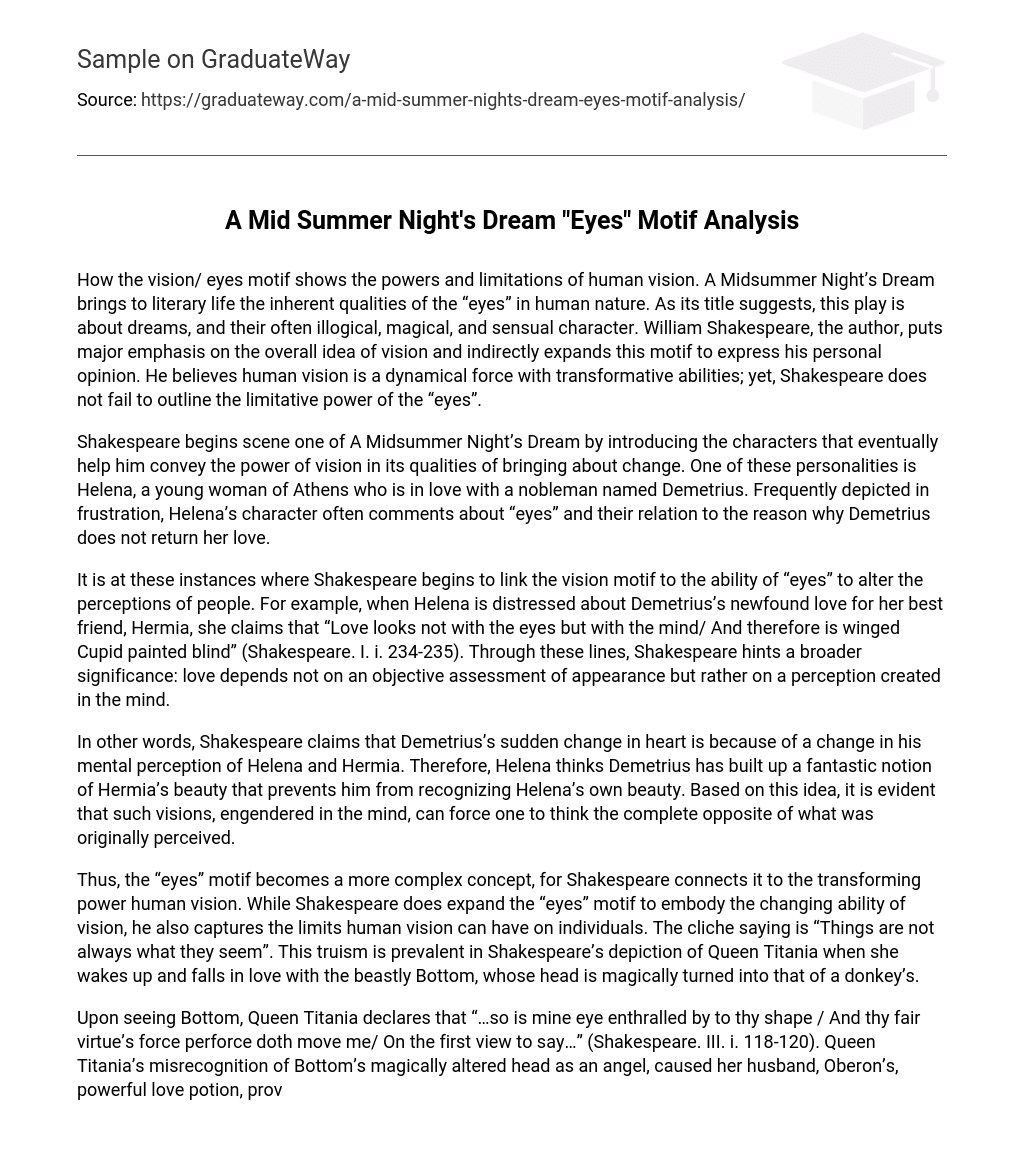How the vision/ eyes motif shows the powers and limitations of human vision. A Midsummer Night’s Dream brings to literary life the inherent qualities of the “eyes” in human nature. As its title suggests, this play is about dreams, and their often illogical, magical, and sensual character. William Shakespeare, the author, puts major emphasis on the overall idea of vision and indirectly expands this motif to express his personal opinion. He believes human vision is a dynamical force with transformative abilities; yet, Shakespeare does not fail to outline the limitative power of the “eyes”.
Shakespeare begins scene one of A Midsummer Night’s Dream by introducing the characters that eventually help him convey the power of vision in its qualities of bringing about change. One of these personalities is Helena, a young woman of Athens who is in love with a nobleman named Demetrius. Frequently depicted in frustration, Helena’s character often comments about “eyes” and their relation to the reason why Demetrius does not return her love.
It is at these instances where Shakespeare begins to link the vision motif to the ability of “eyes” to alter the perceptions of people. For example, when Helena is distressed about Demetrius’s newfound love for her best friend, Hermia, she claims that “Love looks not with the eyes but with the mind/ And therefore is winged Cupid painted blind” (Shakespeare. I. i. 234-235). Through these lines, Shakespeare hints a broader significance: love depends not on an objective assessment of appearance but rather on a perception created in the mind.
In other words, Shakespeare claims that Demetrius’s sudden change in heart is because of a change in his mental perception of Helena and Hermia. Therefore, Helena thinks Demetrius has built up a fantastic notion of Hermia’s beauty that prevents him from recognizing Helena’s own beauty. Based on this idea, it is evident that such visions, engendered in the mind, can force one to think the complete opposite of what was originally perceived.
Thus, the “eyes” motif becomes a more complex concept, for Shakespeare connects it to the transforming power human vision. While Shakespeare does expand the “eyes” motif to embody the changing ability of vision, he also captures the limits human vision can have on individuals. The cliche saying is “Things are not always what they seem”. This truism is prevalent in Shakespeare’s depiction of Queen Titania when she wakes up and falls in love with the beastly Bottom, whose head is magically turned into that of a donkey’s.
Upon seeing Bottom, Queen Titania declares that “…so is mine eye enthralled by to thy shape / And thy fair virtue’s force perforce doth move me/ On the first view to say…” (Shakespeare. III. i. 118-120). Queen Titania’s misrecognition of Bottom’s magically altered head as an angel, caused her husband, Oberon’s, powerful love potion, provides a powerful example of the inadequacy of using vision as the basis of love: she claims Bottom’s body has “enthralled” her so much that she fell in love with him on “first view”.
Oberon’s love-potion works much as Cupid’s arrows are reputed to do: by impairing vision. The juice charms Queen Titania’s sight, so she is unable to see her lover for what he really is. Thus, Shakespeare illustrates the limits of human vision, especially in conjunction with the abstract concept of love. The potion indirectly blinds the Queen to such an extent that she cannot distinguish reality from fantasy. When love is seen with the eyes, as in this case, it becomes a baseless concept, thwarting rationale visually and mentally.
Hence, Shakespeare reveals that the power of human vision also has its limitations. Evidently, William Shakespeare proves his belief that the human vision is a concept that holds a certain transformative power, but has its own constraints as well. He depicts that ideology through his comical play, A Midsummer Night’s Dream in the form of the various characters and their different circumstances and successfully shows this ambivalent nature of the “eyes”.





